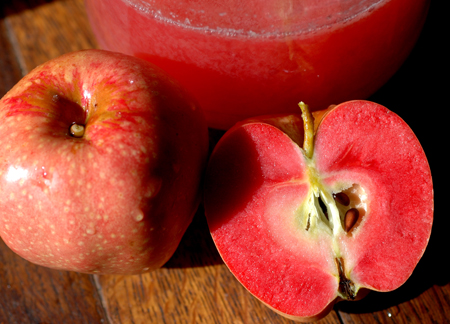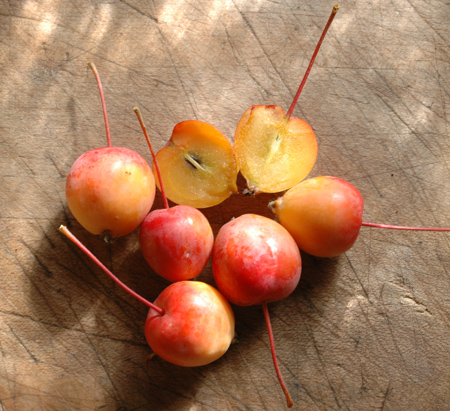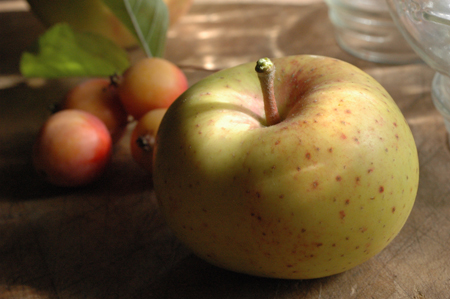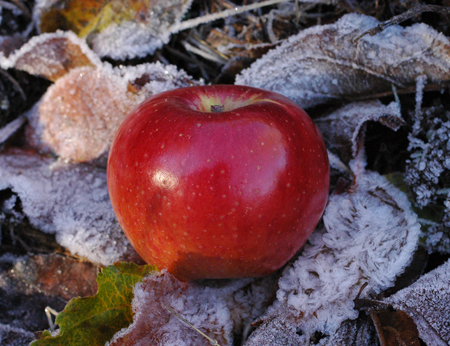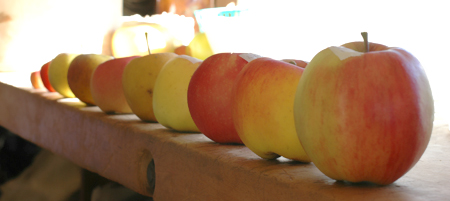 Here are my tasting notes from mid to late season. The Late season extends quite late here with Lady Williams coming in at the end of February. For notes on earlier apples and my thoughts on tasting and evaluation in general, see the previous post, Red Astrachan to King David. I did not review every apple I tasted this season. If something was really good, I'm inclined to mention it, but I feel I need more time to live with many of them before I make any judgement at all. Young trees don't always produce exemplary fruit, and it can be difficult to judge when to pick and eat apples. I also reserve the right to change my mind in the future as I encounter more specimens of various apples and maybe find new benchmarks for comparison. And, as always, what does well here in sunny (often hot) Northern California might not do so well where you live, and vice versa. This time around I’ve stuck mostly to apples that I did actually really like, or had a lot of, and passed by many that were just not that interesting. Some of these fruits are presented in the order of ripening, and some aren't... if that makes any sense... if that doesn't make sense, I guess I'll just give up and get on with it.
Here are my tasting notes from mid to late season. The Late season extends quite late here with Lady Williams coming in at the end of February. For notes on earlier apples and my thoughts on tasting and evaluation in general, see the previous post, Red Astrachan to King David. I did not review every apple I tasted this season. If something was really good, I'm inclined to mention it, but I feel I need more time to live with many of them before I make any judgement at all. Young trees don't always produce exemplary fruit, and it can be difficult to judge when to pick and eat apples. I also reserve the right to change my mind in the future as I encounter more specimens of various apples and maybe find new benchmarks for comparison. And, as always, what does well here in sunny (often hot) Northern California might not do so well where you live, and vice versa. This time around I’ve stuck mostly to apples that I did actually really like, or had a lot of, and passed by many that were just not that interesting. Some of these fruits are presented in the order of ripening, and some aren't... if that makes any sense... if that doesn't make sense, I guess I'll just give up and get on with it.
Old Nonpareil: Light, juicy, pleasing, easy to eat. Old Nonpareil has been very enjoyable eating this year. Old Nonpareil has a difficult to describe quality that makes me think of some candy that I can’t remember, if it ever even existed in the first place. It is not particularly intensely flavored or rich though, and is more along the lines of a light refreshing pleasant apple. Everything seems to come together pretty well for an enjoyable eating experience. It has something of a citrus quality, but I’m not sure if that's due mostly to the acidity or actual flavor compounds in the citrus realm. Either way, citrus comes to mind, and not just to my mind. Like many old apples, it is not crisp or crunchy. It is alleged to keep well, but we didn’t have enough to try keeping any, especially since they seem to be prone to dropping from the tree before they are ripe. The branch is in the shade and this is it’s first year bearing significant fruit, so I’m not sure the fruit is exemplary. For now I’ll look forward to eating them when I can get them, and will probably graft a branch in a sunnier location for further evaluation.
Wickson: Hella intense flavor in a tiny sugar filled package. YUM! This tiny apple is named after then famous California Agronomy champion Edward J. Wickson, who had a large impact on agriculture in the state early in the 20th century. Albert Etter must have recognized great quality in this fruit to name it after his friend and associate, who was an important figure at the time. Everyone loves a Wickson. Early in the season it did taste a bit oddly like crab (it is a crab apple after all), but the seafood element faded as the season moved on. The latest specimens, though cracked from fall rains, were intensely flavored with insane amounts of sugar. It is difficult to describe the flavor of Wickson, so I won't try, but it really is awesomely, rich and unique. The only apple I've had that was close to similar in flavor is Crimson Gold, another Etter variety, which is also delicious, though not as intense. (edit: tonia says that if an apple could have umami, it would be wickson. Adam of Adam's Apples blog describes one of the flavor components as malt. I know what he means, though I wouldn't say that specifically, and haven't been able to characterize that flavor by comparison to anything else.) I've heard two people this year say that if they could have only one apple it would be Wickson... one was a fruit expert and one was my mom. During a talk on apples and apple growing, when asked what trees he would recommend planting Tim Bates said with confidence and practically before the question was finished, "WWWICKSON!". He also added that when interns stay on the Apple Farm, Wickson is always their favorite apple by the time they leave. Find one to eat, graft a branch, graft a tree, graft two, Wickson rocks!
Karmijn de Sonneville: Ginormous cox decendent. I tasted this Cox’s Orange Pippin/Johnathan cross from September through late October at least. Most of my notes are very positive, though my memory is not equally positive. The apple is very tart and that characteristic never mellowed much. Karmijn de Sonneville had very bad watercore on frankentree the first few years, but seems to be getting over it now that the tree is bearing more regularly. The tree that I planted of it in the garden orchard had horrible watercore this year and not a single good apple was harvested. I’m hoping it will come around as the tree matures.
here are some excerpts from my notes on Karmijn de Sonneville:
Oct 15th riper now. still very tart, probably too tart for some. Delicious though. citrusy with other fruit flavors. Very juicy, pretty rich, fairly complex. The perfect apple for people who like to chew on lemons, it has a sensational level of tartness with strong undercurrents of relatively complex flavors. Add to this a great texture and lots of juice and no wonder the Karmijn de Sonneville is a common taste test winner.
Oct 29th very good. Citrusy, pretty tart, yummy coxlike thing.
Grenadine®: a fun apple that tastes as red as it looks. Grenadine® is a rather obscure apple bred by Albert Etter of Ettersburg in Humboldt County California. He was working on red fleshed apples, and this is the reddest of those available. Grenadine® has one major issue (texture) and probably would not have been released in Etter’s time... and wasn’t. Still, it is a remarkably flavorful apple with strong berry or fruit punch flavors. Everyone seems to love it, and I’m quite fond of it myself. The flesh is very dark pink, bordering on red. The longer it hangs into early winter, the more intense the flavor becomes, but it also becomes more mealy. Last year it was not as mealy as it is was this year. It requires a long season for ripening. This year it was probably at it’s best compromise between mealy and fully flavored around mid November. I haven’t tried all the red fleshed Etter apples that are out there, but my guess is that another couple of generations of breeding would have yielded better specimens than are available now. Greenmantle Nursery maintains a trademark on the name and doesn’t want anyone growing it without buying the trees exclusively from them and signing an non-propagation agreement, thus all the little ®'s. As a result, the apple is very uncommon, but cuttings of it show up at scion exchanges, and it is not patented.
The apple formerly known as Rubaiyat®?: Red flesh, red flavor, more please! This is the Albert Etter apple trademarked as Rubaiyat® by Greenmantle Nursery. The fact that Greenmantle limits propagation and demands royalties under that name serves as a disincentive to use it. Perhaps if it had another name it could become popularized and thoroughly assessed by apple collectors and fruit growers, and could possibly even be found for sale now and then. I had just a few of these on frankentree this year. Many dropped from the tree prematurely and only one really fine specimen was harvested. That specimen was, however, delicious! The Texture is open and juicy with berry like flavors common to Etter’s red fleshed apples. Grenadine® has stronger flavors, but this one seems to have better texture and is generally a more refined fruit. I’m reeeeally looking forward to taste eating more of these.
Becca’s Crab: Tiny, crabby, but yummy. My buddy Becca the farmer sent me some scions of this from North Carolina. Apparently in came out of a university research orchard or something like that. She said it made great cider. I distributed some to other apple collectors and cider makers. My scions died when a piece of frozen meat was set on them in the refrigerator, but one single bud miraculously lived. It didn’t even grow the first year, but did the following year and it fruited quite a bit this year. The apples are about an inch in diameter, beautifully red, round, with a deep yellow/orange flesh. I ate some in the fall and more later in the December and January. They hung well without going really soft. A few were left hanging on January 1st, but many were starting to rot. I picked them and the few that were still good were delicious. The late ones had a lychee flavor as tonia pointed out. The earlier ones were reminiscent of cherries, especially when eaten seeds and all. It is a little crabby, with a marked astringency and it can also be somewhat mealy, but given a pile of them, I would probably eat a lot. We’ll see what I think of it after living with it a few years. If it makes great cider too, which seems not unlikely, I’d say this is a pretty swell little apple. I may actually graft a whole tree of it. Wish I had a few to munch on right now. I wouldn't be surprised if this is a common named cultivar, but I don't know my crabs, so... Does it look familiar to anyone?
Pomo Sanel: Local discovery falls short... This apple hung really late. I picked the last ones on January first. The texture was still firm. The latest specimens had some skin blemishes and pitting, but were not rotting or anything like that. The flavor is fairly rich, but not complex being dominated by a banana like flavor. Banana not being my favorite, I found them inedible, even though I kept trying to eat them. Suffice to say, the Chickens got to eat a lot of them. Too bad because I am looking for late hanging apples. This is probably an old known variety, but who knows, it might be a local seedling. It came from a scion exchange and I believe the bag said it was from an old homestead or farm in Talmage. I assumed that it was named by whomever collected it. I would not say it was a bad apple at all, but just not excellent and not to my tasts, so I will not continue growing it.
Newton Pippin: A most praised and praiseworthy apple. (a.k.a. Newtown Pippin, Albermarle Pippin): There is a tree of this famous American apple on the property next to us. I grafted it onto frankentree some years back because the old tree is so decrepit that I figured it didn’t have long to live. In fact, one of the three trees I took cuttings from fell over and died within a year. I had a few late harvested apples off the remaining Newton Pippin this year, and it they were similar to other good newtons I’ve had. There is a strong fruit flavor like jolly rancher candy, sometimes the watermelon flavor and sometimes just generic fake candy flavor. I’m very intrigued. I’ve been told numerous times that Newton will not do well here, but I’m not convinced. (Recent conversations with local growers indicate that it probably does fine here, but that it may take a very long time to come into bearing and is scab susceptible.) Interestingly, the apples that I harvested off frankentree, which were grafted from the original tree are not nearly as flavorful. Still, they were quite good and when eaten out of the fridge in late January were of a very welcome quality. I’m also looking forward to trying a couple of highly rated offspring of the Newtown Pippin- the Virginia Gold (Golden Delicious X Newton) and the New Rock Pippin, an English seedling of Newton Pippin purported to keep extremely well. Virginia Gold scions just arrived and I’m working on getting New Rock Pippin into the country with the help of apple super enthusiast John Gasbarre of Lamb Abbey Orchards. The Newton Pippin has an interesting history, but I’ll save all that for another time and place. for a little more on Newton Pippin check Orange Pippin.
Hauer Pippin: Hoped for better, still hoping... I’ve been really excited to try this apple, but it turns out I’ve been trying it for a few years under the pseudonym of Rose Pippin. I planted a semi dwarf tree of it on recommendation from a friend in Santa Cruz County who is especially fond of it and knows his apples. Axel of the Cloudforest Cafe is also very fond of it. To me, it did not have Wow flavor and it didn’t actually store that well. The texture after a short time in refrigerated storage was bordering on mealy. The flavor is hard to describe. There are some subtle notes of cinnamon candy that I like, but the dominant flavor is somewhat peculiar, very subtle and impossible to nail down. It’s almost more of a sensation than a taste, like alkalinity or acidity are. I’ll try this a couple more years and hope that it comes around. Maybe I have to pick it earlier and store it, but so far, not so good, although it hangs late and is not a bad apple by any means when it is still firm. I just want more out of it if it’s going to have a whole tree to itself.
More on the Hauer Pippin by Axel Kratel here:
Lady Williams: Super late and quite tasty, Lady Williams scores more points! Lady Williams was encouraging this year. One tree was drought stricken (no water and heavy competition from a huge Poison Oak bush) and had poorer quality apples. The apples off frankentree were much better. As usual, they ripened late January, being pretty prime right around Feb 1st. Lady Williams is a tart apple, but by the time it is really ripe on the tree, the high measure of acidity is balanced by a shit ton of sugar! It is a very sweet apple. Flavor is also strong and I guess I would say fruity for lack of any specific descriptors. The one odd flavor I picked out was on the drought stricken tree, Oregano of all things. Those fruits were very stunted though. Lady Williams is a descendent of Granny Smith and the parent of Pink Lady, which seems to be the best supermarket apple out there. The Lineage is... French Crab begat Granny Smith, begat Lady Williams, Begat Pink Lady... Lady Williams looks like a keeper for sure since it is not only extremely late, but it is quite good as well. It requires this long season to ripen though, which would seem to limit its distribution to only a few areas. It will withstand considerable frost and freezes, but I'm sure there is a limit. We rarely see temps as low as 20 degrees.

